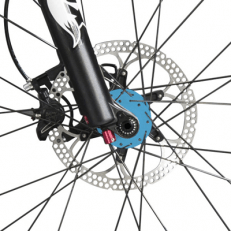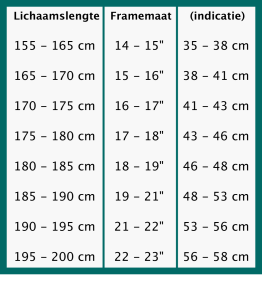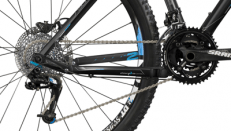Choosing the right mountain bike depends on a number of things. It is not only the choice between tire sizes (a 27,5 inch of a 29 inch), or between a bike with only front suspension (hardtail) or one with front and rear suspension, the so-called full suspension. How much travel do you want to have on your suspension, what kind of groupset does the bike carry, what’s the frame size, sometimes indicated in inches, sometimes in centimeters, and sometimes in simple S, M, L or XL size. And then there are bike types: XC, Enduro, gravity. What does it all mean? In this GearGuide we hope to answer a number of these questions for you.
The choice of your mountain bike depends largely on your budget. There is a lot to choose from and there are many factors that influence your choice. So you first need to determine what your budget is. There are big price differences between bicycles. This is determined largely by the components with which your bike has been assembled. Do you want a carbon frame or aluminum; there are slick electric shifter systems, and a variety of quality in drive trains. In addition to price, it is especially important to think carefully about your riding style. That is, what kind of riding do you plan to do and where. From soft flowy cross country cycling routes, through single track trails in the mountains to heavy downhill in bike parks. What do you want to do?
However, making a choice is less complex than you might think. The Gearlimits GearGuide offers you a roadmap.
Subjects:
Styles
Geometry
Wheels & Tires
Brakes
Vering
Framemaat
Saddle (s)
Drivetrain
Pedals
Types
There are many different MTB types. Each type has a different setup and combination of geometry, travel, wheel size, etcetera. Of course, there are crossovers made in any which direction. But just as a general indication:
In this chart, we made a subdivision along the type of riding you may want to do. There are bikes for each style, with some generic tips we can give you. If you want to ride distances, climb well and trails are not too technical (i.e. lots of turns, stony and with steep downhill sections), then it’s good to look for a stiffer and lighter bike, with a slightly more compact frame. Not too much travel (100-110 millimeters front and little or no suspension on the back) and big 29 inch tires. Many manufacturers will use XC for this type of bicycle.
Going into more mountainous terrain, expecting to do stony descents in shorter more technical routes, choose a bike with a bit longer wheelbase, more travel on your suspension and certainly full suspension. 27.5-inch tires will certainly make a lot more sense now (read why further on). Mostly, this type of bicycle will be called enduro or all-mountain bikes.
Do you really want to go downhill in bike parks than choose for “long” bikes, with 200 mm travel on front and back suspension or even more? A real downhill bomber will sport a thick back suspension, coiled or damper, often wider tires and a geometry that puts your body back and brings it lower over the bike, a wider wheelbase and a slacker front tube ensure a stable ride at higher speeds. Carbon makes less sense when being lightweight is not that much of an issue anymore. This category is called Downhill of Gravity.
Brakes
Not too long ago you could spot many a mountain biker with now old-fashioned V-brakes or rim brakes. They weighed less, the cost was lower and were good enough to slow down the bike.
The disadvantages of a rim brake (and the advantages of a disc brake) have ensured that in the past few years you hardly see any V-brakes on most serious MTBs.
First of all, the braking power of a V-brake or HS33 is less than that of a hydraulic disc brake. That’s already obvious in dry weather, but with rain, a disc brake is far superior! Also, the abrasive action of the brake pads causes the rim to wear out. Those who cycle a lot of rain must check the rims on a regular basis. A worn rim can cause wheels to break a.k.a. monster crashes.
All reasons that on most bikes the rim brake has been replaced for a disc brake. The disc brake will always have the better stopping power! Particularly when mounted on the wheels of a full suspension, the disc brake brings the speed on a bike down faster, safer and with less effort. Cramp in your fingers on long Alpine descents are a thing of the past. It just makes every descent that much safer and more fun. And that’s what it’s all about …
Important in all brakes is not only the stopping power but how well the braking action can be applied. Progressive brakes enable riders to really apply the exact amount of pressure needed, feathering the brakes when needed and slamming them tight when necessary without having the brakes block the wheels at the wrong moments. A blocked wheel equals loss of traction equals loss of control.
So when you test ride your bike, be sure to try them out and different speeds and using different pressure on the brake levers. See what happens and how it feels.
Suspension
Suspension systems with a lot of travel and multi-adjustable dampers are widely used today. In this case, the choice of a fully open setting varies through a setting that eliminates negative effects of pedaling on the suspension (bouncing), until a full blocking of the damper that gives almost a hardtail feel. 100mm suspension (also known as “travel”) in the front and back and is now often the least you will see, and can just rise to 180mm and downhill bikes even 200mm plus. These millimeters stand for the distance that the damper can take or travel within itself when dealing with the challenges of the trail.
Front suspension only
If you ride mainly on soft flowy trails, a hardtail with a front fork suspension is an excellent choice. A hardtail is lighter, less maintenance-sensitive than a full-suspension bike and cheaper. The money you save by doing without rear suspension could be spent on higher quality and lighter parts for your bike. Or on must have accessories like a helmet or a good jacket. With a hardtail, you can also cycle in more mountainous terrain, certainly when going up. If you don’t plan on bombing down the mountain, you can go down with a hardtail. But descending is faster, safer and more comfortable with a full suspension. Disadvantages: less comfort, less traction and less control.
With a hardtail, you can also ride in more mountainous terrain, certainly on ascents. If you don’t plan on bombing down the mountain, you can go down a trail with a hardtail. But descending is faster, safer and more comfortable with a full suspension.
Full suspension
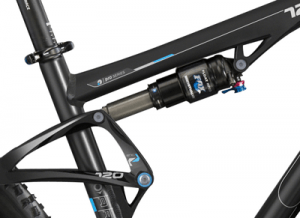 The main arguments that call for full suspension are comfort and safety. With front and rear suspension, you are less affected by uneven, bumpy, rocky terrain. The suspension absorbs the unevenness in the terrain and by doing that ensures your tires are in contact with the ground longer and better. That means more traction and control: equals safety and fun.
The main arguments that call for full suspension are comfort and safety. With front and rear suspension, you are less affected by uneven, bumpy, rocky terrain. The suspension absorbs the unevenness in the terrain and by doing that ensures your tires are in contact with the ground longer and better. That means more traction and control: equals safety and fun.
And what many people do not know: it’s better for your back and is easier on the muscles. Various scientific studies have shown that full suspension helps to lessen muscle fatigue. All the impacts absorved in the suspension doesn’t need to to be absorbed by your muscles.
If you ride in mountainous terrain on a regular basis then a cross-country bike with a minimum of 100mm centimeters of front and rear suspension is the least you should bring with you. If you like to do alpine single track, it’s best to take along an all-mountain or enduro bike. These features a minimum of 120mm suspension (up to 160mm) and will be easy to maneuver over faster and rougher trails.
There are some disadvantages to the full-suspension mountain bike as well. You can add an additional cost of about five hundred euros against a hardtail, and a weight of at least half a kilo. And it will require more maintenance.
Frame size
 It is important to choose a bike with the right frame. It is very important that you fit a bike to your body length and build. In the table below you can find a general indication of the relation between your body length and the frame size that could be good for you. But always feel the bike and do not buy blindly solely based on frame sizes.
It is important to choose a bike with the right frame. It is very important that you fit a bike to your body length and build. In the table below you can find a general indication of the relation between your body length and the frame size that could be good for you. But always feel the bike and do not buy blindly solely based on frame sizes.
Afbeelding: Niner Air9 Carbon frames
The chart below is an indication of what frame size fits which body size. However, nothing beats getting on the bike an trying it on for size.
Saddle’s and seatposts
An easily adjustable seat post is an absolute must. You need your saddle to be high while climbing and, down while descending. With a tour-oriented mountain bike, the saddle is just slightly higher than the bars. This offers a more relaxed body position, better visibility, (because you’re sitting more upright) and better weight distribution when descending.
MTB XC riders often choose a deeper, more efficient, but less comfortable seat with the bars lower than the saddle.
A “dropper post” offers a lot of flexibility in adjusting your seat height while riding. It consists of two sliding tubes that together form the seat post. The upper tube can slide partlyinto the lower tube, by means of a mechanical spring that can be clamped or air suspension. From your handlebars you can operate the dropper post with a lever which allows the saddle to be raised or lowered depending on whether you are descending or climbing.
Especially when descending at higher speeds or in very steep sections a lowered saddle means your saddle is out of the way so that your bike can move freely between your legs. Added to that you can drop your body weight more easily and bring it back over your rear tire. This will significantly reduce the chance of going over the bars.
Saddle choice
Choosing a saddle is difficult because there is just a lot to choose from. The most important thing about your saddle choice is to determine the distance of your sitting bones with which you sit on your saddle. A good way to find our this distance is to sit forwards on a piece of ribbed cardboard as you would sit on a bike. The indents on the cardboard you see when you get up are those of your sitting bones. The distance between these indents is the minimum width of your future saddle. When the sitting bones are supported by the saddle, the largest part of your body weight is carried on the bone and relieves the ‘softer parts’ of your anatomy much more. For some people, a hole in the saddle relieves the pressure even more because the pressure is distributed differently. Always check where the issues are and then look for a suitable saddle. Many bike specialty stores have test saddles. By testing different models you will be able to make a good choice.
Drive train
A good drive train is essential. Expensive Shimano and SRAM groups are not only lighter, they are more accurate when shifting and more durable. Good and affordable quality already begins with Shimano Deore or SRAM SX5. A large part of the price of a bike is influenced by the quality of your drivetrain. Think carefully about the type and intensity of riding you are thinking about and how much you want to invest in a group.
Traditionally we have seen triple and double chainrings on cranksets with front derailleurs to shift between them. The past few years there has been a strong development towards single chainrings, you will see groups with only one chainring on the crankset, and for example 11 or 12 gears on your cassette. In those cases there is a large difference between the smallest and the largest cog, offering ranges of 10 / 11 tooth up to 46 to 50-tooth.
The advantage is that you only have to shift gears on your cassette. There is no front derailleur, so less maintenance or risk that something breaking there. The wide range of the cassettes still ensures that even in the mountains you can ride light enough. The disadvantage is that you have less choice and that you may miss the smaller intermediate gears.
Pedalen
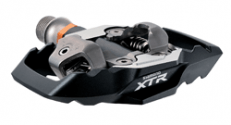
An important choice for any mountain bike at any moment is the choice between clipless pedal and so-called “flat” pedals. We first look at clipless pedals. The name clipless is a bit of a misnomer because you know that with these pedals, your shoe (special shoes are required) is on the pedal. The name actually comes from the time when the pedals had a complete clip over the shoe that actually shoved your shoe. When Shimano came with his SPD system, those pedals were without these clips; Shimano’ss pedals in effect became clip-ins.
SPD
Pedals for mountain bikes are often outfitted with a SPD click system (SPD = Shimano Pedaling Dynamic). The advantage of SPD pedals is that your bike shoe clicks and fastens onto the pedal of your mountain bike. This makes it possible to not only push, but also to pull on the pedals. Your pedaling becomes more efficient and powerful. This is especially important while climbing.
SPD pedals allow little to no movement of the foot relative to the pedal. There are pedals that allow a small turn, such as the SPD-SL pedals. Pedals are available in several versions. Shimano has a pedal in its range, but also well-known brands like Ritchey and Look carry different SPD pedals.
Prices of this kind of pedals are generally determined by the quality of the materials used and the quality of construction.
A brand like Crankborthers also produces so-called “egg-beater” pedals that also provide clip-in but with a different technique than SPD pedals.
Flats of Gravity pedalen
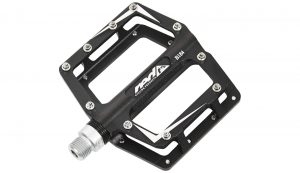
These are pedals without a clip system and with a very wide surface on which the foot stands. This allows for as much contact between shoe and pedal as possible. To further enhance the friction between pedal and shoe (and lessing the chance of the shoe slipping on the pedal), you often see several rows of rather aggressive spikes or anti-slip pins that will bite into the sole of the rider’s shoe.
Therefore, you do not need special shoes for these pedals, although a stiff sole is always recommended (also with clip-in shoes). The stiffness of the sole contributes to contact and control, as well as the efficient transfer of the power from your legs to the pedals.

